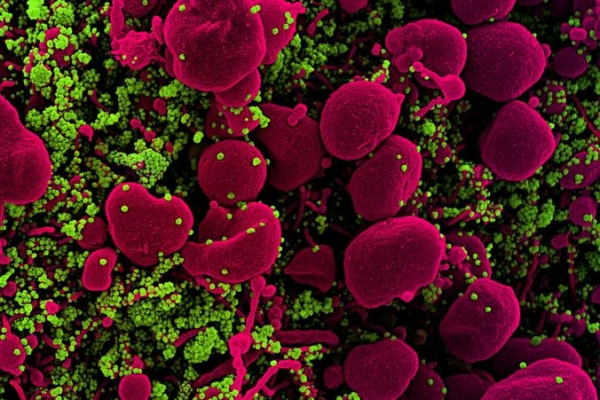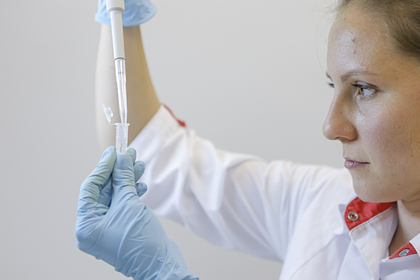
Coronavirus is settled in the world. The good news is that the vast majority of people recover, while many are marked only mild symptoms. In Russia already more than 13 thousand recovered. Survivors coronavirus infection, talk about the symptoms that was the place to be.
It is very important to monitor your body and symptoms that occur in it. In this review, we consider the 13 symptoms of the coronavirus, and how to distinguish coronavirus flu, colds, allergies.
Common symptoms of coronavirus in humans
According to the world health organization, the coronavirus infection is manifested by fever, dry cough and shortness of breath. There may be muscle pain and General fatigue. Less appears runny nose, sore throat, diarrhea, and gastrointestinal disorders. Experts from the UK say that the sudden loss of smell or taste can also be a symptom of infection (this may be particularly true for young people).
We must remember to follow the changes in our body and not to underestimate a cough or a runny nose, if we notice alarming symptoms.
1. Cough associated with coronavirus as the primary symptom of the disease
Cough is one of the main symptoms of the coronavirus, but not every type of cough indicates that you have COVID-19.

For doctor useful information about the cough that will help to assess this symptom, will be:
- duration of cough is important, if the symptom lasts for several days, or for weeks or months;
- when the cough increases at night, in the morning or may be irregularly during the day;
- sounds like the cough – it can be dry, barking (a type of dry cough), wet or suffocating;
- what is the severity of the cough – the cough may be unremitting, or intermittent debilitating, and sometimes also hinder the performance of daily activities;
- does the cough additional symptoms such as vomiting, dizziness or insomnia.
About half of infected by the coronavirus SARS-CoV-2 have a cough. When COVID-19 dry cough and constant, which is the result of irritation of the lung tissue. Muscle pain and shortness of breath also appear when you cough. Fluid accumulates in the lungs as the progression of the disease, so eventually there is difficulty breathing.
Than wet cough differs from a dry cough?
When the patient’s cough appears, it means that the sputum comes from the lower respiratory tract and not from the nose and throat. The wet sound caused by fluid in the Airways that may be accompanied by wheezing. Infections of the lower respiratory tract accompanied by a wet cough, because they have more secretory glands, than in the throat.
Dry cough sputum does not appear, because the cough reflex starts with the throat. The sound that accompanies this type of cough is a barking or hoarse. Dry cough does not clear the Airways from secretions, so people who experience it, may find it unsatisfactory. It is this symptom characteristic infections that affect the nose and throat, for example, the flu or colds.
Sometimes, the dry cough becomes a wet cough. An example would be pneumonia. Initially there is a dry cough that can be painful and take place with worsening shortness of breath. Over time during inflammation allocations start to fill the alveoli, and fluid and blood is the lungs. Then, the cough becomes wet. At this stage of the disease the sputum becomes frothy and stained with blood.
2. Diarrhea as the first symptom of coronavirus in humans
A group of Chinese medical experts from Wuhan engaged in COVID-19 (Wuhan group of experts on medical treatment for COVID-19) came to this conclusion after analyzing data collected from 203 patients with coronavirus infections SARS-CoV-2, confirmed in the test. It was patients who were admitted to three hospitals in Hubei province in the period from 18 January to 28 February 2020. The scientists had complete clinical and laboratory data, and imaging results. The average age was about 55 years old.
It turned out that almost half (48.5%) patients with COVID-19 complained of gastrointestinal symptoms, such as:
- anorexia (84%),
- diarrhea (more than 29%),
- vomiting (0,8%),
- abdominal pain (0.4 percent).
In seven cases was observed only gastrointestinal symptoms without respiratory symptoms.

In addition, they draw attention to another aspect. Coronavirus was detected in the stool samples of patients with COVID-19. This means that although a person can be infected mainly through the respiratory tract, the digestive system can be another potential way of infection.
3. Loss of smell may be the only sign of human coronavirus
Sudden loss of smell is a symptom of coronavirus infection.
One of the problems which prevents to stop the epidemic of the coronavirus SARS-CoV-2, is the asymptomatic nature of the infection, occurring in many patients. It can also happen that symptoms of infection of the coronavirus COVID-19 so nonspecific that hardly anyone associates them with the possibility of infection. An example is the sudden loss of smell or anosmia.
The lack of smell has an innate character, but it also manifests itself in the form of the acquired disease. Often the loss of smell is the result of a cold or other upper respiratory tract infections, including those caused by coronaviruses. Recent reports indicate that anosmia is also widespread among people infected with the coronavirus SARS-CoV-2. In South Korea, to 30% of patients with confirmation COVID-19 broke, problems with the sense of smell.
British researchers Sinologicheskoj Companies indicate the special nature of anosmia in the context of the coronavirus that causes loss of smell and taste may be the only sign of infection. If there are accompanying symptoms such as fever or cough, a person with anosmia is unlikely to be tested for the coronavirus. Currently, most countries are tested or excluded only patients that meet certain criteria. Experts suspect that people who have experienced sudden loss of smell, may be hidden carriers of the coronavirus and be responsible for the rapid spread of the infection.
4. Nasal congestion and pressure in the ears
Painful sinuses and nasal congestion can take place even in the cold. However, Connor Reid, a British resident of the Chinese city of Wuhan, very accurately described, as he developed coronavirus infection. Connor, a native of North Wales, had contracted the coronavirus in November 2019, a month before the Chinese government officially announced the outbreak.
In his diary he wrote: “This is not just a cold. I have headaches all the time like a crack head, my eyes are burning, my throat constricted. My sinuses are clogged, and the eardrums are about to burst. I know I shouldn’t, but I have to massage the inner ear with a cotton pads trying to remove the pain.”
One of the most common first symptom of coronavirus is the tightness or tightness in the ears.
According to Connor, another symptom of coronavirus is a tightness in my ears, which makes them feel “ready to fire”.
In the case of a cold or flu, we often give the impression of laid the ear in which the pain increases. Usually this is due to blockage of the ear of the tubules due to high pressure due to the presence of the virus in your body.
5. Severe headache as a symptom coronavirus
Strong, throbbing headache is a common symptom not only in the fashion industry, but also cold or flu. It can also be a sign of fatigue, dehydration and even lack of iron in the body. Don’t forget to drink plenty of water, rest and try to relax.

Experts in the field of health suggest anyone who suspects that a coronavirus infection, take paracetamol instead of ibuprofen.
6. Burning eyes
Infrequent symptom of coronavirus is a burning sensation in the eyes. The best way to describe burning sensation in the eyes – to compare it with the itch and irritation that you may face during hay fever or allergies. This type of irritation can occur when we are in the center of the smog, smoke, dust, and even animals, if we suffer from allergies.

The only difference between these cases and cases reported patients with mers is that the virus causes this symptom, and not an external factor, such as smoke or animals.
7. Sore throat as a symptom of the infection of coronavirus
Patients infected with the virus COVID-19, usually feel a mixture of symptoms of flu and colds. However, soreness of the throat is often the result of persistent cough. Furthermore, it is in the throat has the highest concentration of viral particles. That’s why, often with the tonsils of the throat, take a swab to test for the coronavirus.
8. Pain in the body
Often the flu we are dealing with pain throughout the body, even bones. Coronavirus causes the same symptoms.
Those who got the virus, reported pain throughout the body, not only as a result of clogged sinuses, congestion of the ears or nose, but also in the arms, legs and chest.
9. Lungs “sound like a paper bag”
This type of sound may occur when small bubbles of air in the lungs fill with fluid and air which you inhale and exhale.
As a result of pneumonia, air bubbles can be filled with fluid – a common symptom coronavirus infection. If breathing seems to be wheezing, it can cause bronchitis.
10. Fatigue – symptom coronavirus?
The first symptom coronavirus, which accompanies all inflammation in our body, is General fatigue. Let’s remember that we need as much rest as possible and do not forget to drink the required amount of clean water – at least 1.5 liters per day.

Jami San-Yong became the first citizen of Thailand, who had the coronavirus in December last year.
Despite major diseases, including heart problems, JAMA survived after doctors isolated him from others.
11. Lack of appetite is also a symptom of coronavirus
Many patients with the coronavirus noted that can not normally eat when suffering from coronavirus. Any weakness caused by colds, flu or a virus that reduces people’s appetite. You have to remember to try to maintain the basic daily rate of calorie coming into our body, because it will help in the fight against the disease.
12. Fever and coronavirus
Fever is the first symptom that occurs in people infected with coronavirus. When we see her at home, we need to constantly monitor body temperature. If it exceeds 39.5 degrees Celsius, we should immediately notify the relevant service, for some people this is the only symptom coronavirus, which they have.

13. Tightness in the chest
The other most common symptom of coronavirus is chest tightness and persistent cough.
Many scientists and medical professionals warn that drops outgoing when coughing or sneezing, are the main cause of the spread of the virus, so we must pay so much attention to hand washing while in case of cough and runny nose we have to remember about using disposable wipes every time.
Carl Goldman of Santa CLARITA aboard the cruise liner Diamond Princess, in an article for the Washington post explained that during the flight back to America he had a fever and “was some cough”, and upon return he was placed in quarantine.
14. Sleep problems
One of the people infected with the virus COVID-19, spoke about the symptoms similar to sleep problems that occur with frequent changes of time zones.
Bridget Wilkins, who lives in London, flew to Australia via Singapore for the wedding of her friend – then she got to quarantine to a hospital in Brisbane after a positive test for the coronavirus. 29-year-old patient said that she had the following symptoms: headache, sore throat and fatigue.
Not realizing that she was infected with the coronavirus, she thought that her symptoms were caused by jet lag after a long flight.
15. Faint
David and Sally Abel from Oxfordshire have become stars of the Internet, documenting his journey after infection with coronavirus quarantine on a cruise ship in Japan.
The pair were passengers aboard the “Diamond Princess” and was treated in hospital after a positive test for the virus when they were locked in the cabin.
First pair was skeptical about the diagnosis and suggested that they were not sick, but David later admitted that she felt bad on the way to the hospital, and even losing consciousness.
Comparison of the symptoms of coronavirus with influenza, colds and allergies. Table who
Symptoms
Coronavirus
Cold
Flu
Allergy
Cough
Often (dry)
Rarely
Often
Sometimes
Sneezing
No
Often
No
Often
Diarrhea
Sometimes
No
Rarely
No
Runny nose
Rarely
Often
Sometimes
Often
Sore throat
Sometimes
Often
Sometimes
Rarely
Shortness of breath
Sometimes
No
No
Sometimes
Joint pain
Sometimes
Often
Often
No
Fatigue
Sometimes
Sometimes
Often
Sometimes
Headaches
Sometimes
Rarely
Often
Sometimes
Fever (high temperature)
Often
Rarely
Often
No
Loss of smell
Often
No
Rarely
Sometimes









More Stories
Color wheel online
The Ministry of health has promised to disclose information about the vaccine trials from COVID-19
Called “atypical” symptoms of coronavirus